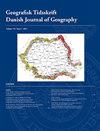了解西班牙短期租赁的空间性:Airbnb和住房商品化的加剧
IF 0.8
4区 社会学
Q4 ENVIRONMENTAL STUDIES
Geografisk Tidsskrift-Danish Journal of Geography
Pub Date : 2020-06-22
DOI:10.1080/00167223.2020.1769492
引用次数: 33
摘要
摘要本文分析了西班牙短期租赁市场扩张的空间性。它是基于该国所有Airbnb房源的地理定位数据。多尺度分析使我们能够确定社会经济、旅游市场和住房存量变量,这些变量对短期租赁服务的扩散影响最大。所获得的结果证实了一种集中模式,验证了我们的中心假设:Airbnb房源分布的不均匀与住房市场产生新利润的潜力具有很强的空间相关性。在全国范围内,Airbnb房源最集中的城市地区是游客需求最高的地区。这些是最大的城市、沿海旅游区和群岛。在城市层面,Airbnb的集中地集中在中心地区,那里的短期租金往往更贵。它们还位于工薪阶层社区,房价较低,由于靠近旅游景点,对投资者来说潜力巨大。这些发现提供了新的证据,证明所谓的共享经济如何在住房商品化的加剧中发挥核心作用,以及这与城市地区的密集旅游是如何相关的。本文章由计算机程序翻译,如有差异,请以英文原文为准。
Understanding the spatiality of short-term rentals in Spain: Airbnb and the intensification of the commodification of housing
ABSTRACT This article analyses the spatiality of the proliferation of short-term rentals in Spain. It was based on geolocalised data for all the Airbnb listings in the country. A multiscale analysis enabled us to identify the socio-economic, tourism market and housing stock variables that have had the greatest influence on the proliferation of short-term rental offers. The results obtained confirmed a pattern of concentration that validates our central hypothesis: the uneven distribution of Airbnb listings has a strong spatial correlation with the potential for generating new profits in the housing market. At national level, the urban areas with the highest concentration of Airbnb listings are those with the highest tourist demand. These are the largest cities, coastal tourist regions and archipelagos. At the city level, clusters of Airbnb concentrations are located in central areas where short-term rentals tend to be more expensive. They are also located in working-class neighbourhoods with lower housing prices with great potential for investors due to their proximity to tourist sites. These findings provide new evidence of how the so-called sharing economy is playing a central role in the intensification of the commodification of housing and how this is correlated with the intensive touristification of urban areas.
求助全文
通过发布文献求助,成功后即可免费获取论文全文。
去求助
来源期刊
CiteScore
5.20
自引率
0.00%
发文量
5
期刊介绍:
DJG is an interdisciplinary, international journal that publishes peer reviewed research articles on all aspects of geography. Coverage includes such topics as human geography, physical geography, human-environment interactions, Earth Observation, and Geographical Information Science. DJG also welcomes articles which address geographical perspectives of e.g. environmental studies, development studies, planning, landscape ecology and sustainability science. In addition to full-length papers, DJG publishes research notes. The journal has two annual issues. Authors from all parts of the world working within geography or related fields are invited to publish their research in the journal.

 求助内容:
求助内容: 应助结果提醒方式:
应助结果提醒方式:


